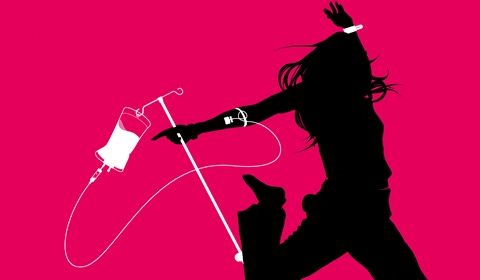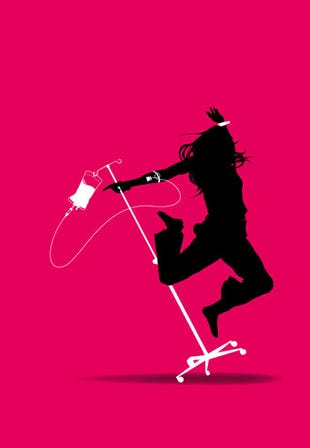The design of a great medical product often requires that the focus be on safety. Design of a great consumer product requires a focus on aesthetics and loyalty—people have to love it. The medical experience and the consumer experience are generally seen to be very different from one another. A medical device is something that is imposed on you and a consumer device is one that is sought out.

The design of a great medical product often requires that the focus be on safety. Design of a great consumer product requires a focus on aesthetics and loyalty—people have to love it. The medical experience and the consumer experience are generally seen to be very different from one another. A medical device is something that is imposed on you and a consumer device is one that is sought out. Medical is something to be tolerated while consumer is something to be enjoyed. And these conceptions are reflected in the design of each type of product. Medical products generally look serious and functional and—let's face it—dull. Meanwhile, consumer products are designed to evoke a delightful feeling from users.
 Historically, the target user groups for medical products and consumer products have also been considered to be very different from each other. But the reality is, these two groups are the same—they are people. So how do we approach the patient/consumer (i.e., person) to incorporate his or her needs into medical device design?
Historically, the target user groups for medical products and consumer products have also been considered to be very different from each other. But the reality is, these two groups are the same—they are people. So how do we approach the patient/consumer (i.e., person) to incorporate his or her needs into medical device design?
There is an increasing overlap between the medical space and the consumer world. And there is a shift in people’s attitudes about healthcare, from management of sickness toward maintenance of wellness. This change is happening in emerging areas such as connected health and consumer wellness, but also in more traditional areas, including drug delivery.
Connected health and health monitoring products, such as telemedicine and other connected devices, need to become a constant in people’s lives because adoption is the key to market success. Adoption hinges on ensuring seamless integration into people’s everyday lives.
The lines between consumer wellness products (such as a pedometer) and medical devices (such as a heart rate monitor) are blurring. Some of these categories of products are tangential to medical products in that they may be regulated but are not prescribed. As such, the devices are typically not covered or reimbursed by insurance. Therefore, consumers must feel compelled to spend their own money to purchase the products. Target markets for such devices include the worried well and caregivers concerned about aging parents, for example.
Even in the traditional space of drug delivery, there is a significant a shift toward a consumer-first approach. For the management of conditions such as diabetes where there is choice in therapies, companies have worked to establish brand differentiation and provide a consumer feel for items such as injection pens. Also, with the proliferation of biologics, the advent of new drug-delivery technologies, and a shift from inpatient hospital care to outpatient care, acute recovery and chronic conditions are increasingly being managed at home. Many of these patients require the delivery of complex drug regimens. Such regimens are driving the need for easy-to-use self-administration delivery systems that can be used in either the home or clinical setting.
Patients and Caregivers Survey
FDA classifies drug-delivery devices intended to be used by patients or lay caregivers as combination products. A combination product is composed of any combination of a drug, a device, or a biological product (i.e., two or more regulated components), such as prefilled syringes, insulin injector pens, metered dose inhalers, transdermal patches, drug-eluting stents, and catheters with antimicrobial coating. Cambridge Consultants, in conjunction with MassMEDIC, recently conducted qualitative research on the patient-related drivers around these types of drug-delivery combination products. Patients were asked about their experiences and priorities in selecting drug-delivery devices. Healthcare providers were also interviewed about the role of the drug-delivery devices in treatment decisions and in patient medication compliance.
More than 240 diabetes patients were surveyed. All of them use a combination product (such as a vial and syringe, prefilled syringe, injection pen, or insulin pump) to administer their medication. The research showed that patients are aware of their options and are driven to a certain extent by lifestyle factors such as discretion, portability, and feature sets. The study also demonstrated that there is some willingness for patients to pay more in order to get the features and convenience that they feel are important.
Patients were asked if they were ever given a choice of devices to use when they were prescribed their medication, and 75% said yes. Of those patients, the largest percentage said they usually take their doctor’s recommendation. At a close second, however, a substantial number of patients said they do their own research and even try out different devices before making a selection.
We also polled patients about whether they have ever asked their doctors if they could change the drug-delivery device they were using. More than one-third indicated that they had. The primary reasons cited for such requests were lifestyle factors such as discretion or portability of the device, as well as factors such as better features and updated technologies.
When asked, most people said they prefer newer technology or better features. However, there is typically skepticism about people’s willingness to pay an extra cost for those things, particularly around medical devices. To address this discrepancy, patients were asked: “If a device was available that was easier to use than your current device but it cost slightly more (~$5) than your current device, how likely would you be to pay more out of pocket for the easier device?” Even with the increased out-of-pocket cost, more than three-quarters of patients indicated that they would be either ‘somewhat’ or ‘very’ likely to change devices.
These overall findings indicate that patients are aware of options, that they are driven to a certain extent by lifestyle factors, and that there is some willingness to pay slightly more to get the features and convenience they think are important. In other words, patients are behaving more like consumers in their approach to their drug-delivery systems.
As part of this same survey physicians and nurse educators who either prescribe these types of devices or train patients to use combination products were interviewed. Professionals came from several specialties, including pediatrics, orthopedics, internal medicine, gastroenterology, and diabetes education. The feedback received from healthcare providers provided further validation to the idea that there is a patient-driven component to the selection and success of drug-delivery devices.
All of the healthcare providers questioned stated that they believe the usability of the delivery device affects patient compliance with the medication therapy. They indicated that efficacy of the medication is a primary concern in making treatment decisions, but that they may not prescribe a medication if they don’t believe the patient can be successful with the dosing requirements. One diabetes educator expressed the idea of matching the drug to the patient and that in doing so, the delivery device “is a piece of the puzzle—a piece that you can’t ignore.”
This research underscores the fact that the least effective treatment is one that is not taken. And the efficacy of any particular therapy is determined by a combination of both efficacy and compliance with the dosing regimen.
So how can we maximize this potential and produce drug-delivery devices that best support compliance and ultimately health outcomes?
Design Strategies
Human Factors (HF) engineering is the discipline tasked with incorporating user considerations into medical development. It is the study of how people use technology. It involves the interaction of human abilities, expectations, and limitations with work environments and system design. HF is integrated into the development process in an iterative manner, typically focused on user research into the safe interaction between people and the medical device under development. User experience design is the approach used to incorporate user considerations into commercial product development. User experience design considers all aspects of the end-user’s interaction, not just the product itself, but also with the company, its services, and all of its products. User experience starts with the intended user and builds the product and all of the components surrounding it to support the intended experience. Ideally it creates a seamless merging of multiple disciplines, including engineering, marketing, graphical and industrial design, and user interface design.
If we consider HF for medical devices, user experience for consumer products, take the best of both of those approaches, and leverage the commonality of tools and methods, what we have is a new approach to medical device design: patient experience (Px) design. Px includes the safety and rigor of HF engineering combined with the broader lens of a user experience approach to create products that patients both use safely and accept willingly.
In practical terms, Px borrows from the evolution in the consumer space and encourages pharmaceutical companies to switch from a drug- or molecule-driven design perspective to a system or service design perspective. Just like iPhones and iPads are merely portals to the broader app store and iTunes services, and the Kindle is merely the device tip of the Amazon iceberg, medical devices can become, through a Px approach, the physical embodiments of a broader compliance- and outcome-based service.
Positioning Patient Experience
The process of defining Px starts at the strategic marketing level by characterizing what the long-term relationship should be between the company, the patient, the caregiver, the community, and the care center (e.g., the hospital). This gives the offering its character, which can flow through all of the product and service requirements. IKEA is exemplary in this respect. Its “Affordable Design for All” motto has shaped not only the products and instruction materials, but also store layout, packaging, shipping policies, and just about every aspect of the business. In short, IKEA’s user experience is complete and consistent.
In the same way, a medical company can define its own overarching Px. At the device level, safety, simplicity, and ease of use are all of paramount importance. But Px would take a step beyond those necessities to consider acquisition, storage, and transport of the device. Does the device allow people to keep, store, and use it where they want to in their homes? Does the device allow for travel? Does it provide privacy and discretion? What are the social circumstances in which the device will be used? Instead of forcing patients to adjust their lives to accommodate the management of their disease, design a delivery device that supports people in leading the mobile and active lifestyles they want to lead.
Moving beyond the device itself, Px expands the scope to include how the device is packaged, (which is often people’s first interaction with a product) and whether the training materials (starter kits, instructions for use, etc.) are effective and continue to support the Px experience. These items are typically designed as afterthoughts to a drug-delivery device and are not always considered part of the device system or experience.
Broadening the lens even further, Px also shapes the device community, which includes the online presence of the therapy. Providing services such as online troubleshooting, instructions, user interaction groups, tracking applications, and online patient diaries can support proper use and compliance with the system and reinforce the overall patient experience.
The Px Approach
The team that executes an effective Px development must be highly multidisciplinary. HF engineers bring the tools to discover what the Px must be and how to navigate usability and safety. Industrial designers and graphic designers bring the Px to life, embodying its principles into well-rounded concepts and interfaces. Engineers and developers anchor all elements in reality and feasibility. The marketing team ensures that the Px is consistent with the overall corporate message and that the value proposition is strong. The key to a successful Px development lies in a shared common understanding of the core values of the desired experience as well as a fierce protection of this vision by the team throughout the entire development cycle.
The key steps toward implementing a Px approach for a drug-delivery or other home-use medical device are as follows:
Commit. Px won’t work with a half-way approach.
Define the overarching vision for the experience of the therapy in a concise and powerful manner.
Generate buy-in for that vision at a high level.
Identify a single person or entity that holds the responsibility for delivering that experience across all elements of the therapy (e.g., the device, the instructions, the packaging, the training materials, the web portal, etc.).
Ensure that each of the teams responsible for developing the different elements maintain the end-user experience as an overall guideline throughout the development, from concept generation through product and service specifications.
Make trade-off decisions throughout the development life cycle that do not compromise the Px goal.
Conclusion
The Px approach may appear daunting at first because of its holistic nature and the large number of moving parts. However, once applied, Px offers a straightforward set of rules for prioritizing and streamlining the development process. It also unlocks synergies between components that will benefit users’ daily lives and in return, gain their loyalty.
Companies that take a broader view of their device development, beyond safety, to address the overall patient experience will be able to realize the potential for much better patient outcomes and improved adoption of their products in the long run. With changes in the healthcare landscape and the dwindling security of patented molecules, ensuring improved health outcomes and maintaining brand loyalty by building a relationship with patients is becoming increasingly critical to the financial success of companies providing the treatment therapies.
Image by iSTOCKPHOTO, GEORGE HOEYLAERTS; digital composition by CAMBRIDGE CONSULTANTS, SERGE ROUX.
+++++++++++++
| Melanie Turieo is a group leader and principal human factors engineer in Cambridge Consultants’ medical technology division. She has more than 15 years’ experience providing human factors expertise and earned a bachelor’s degree in human factors engineering from Tufts University. Reach her at [email protected]. |
| Serge Roux is a principal industrial designer in the medical devices group at Cambridge Consultants (Cambridge, MA). He holds a bachelor’s degree in mechanical engineering from the National Institute of Applied Science and a master’s degree from the Technological University of Compiegne. E-mail him at [email protected]. |
About the Author(s)
You May Also Like




